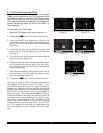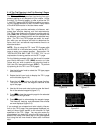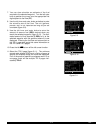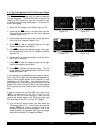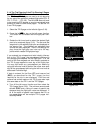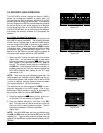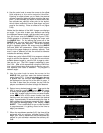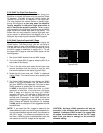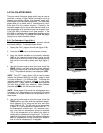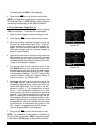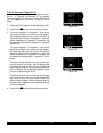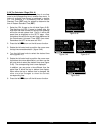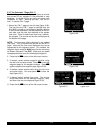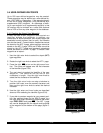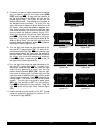
5-10
Rev 1
5.3 CALCULATOR PAGES
There are seven Calculator pages which may be used to
calculate a variety of flight related information such as
pressure and density altitude, true airspeed, winds aloft,
VNAV angle, and time zone conversions. The Calculator
pages allow you to make “what if” calculations for condi-
tions other than the present situation. Therefore, the
Calculator pages rely on you to make manual inputs of air
data parameters such as altitude and true airspeed even
if the KLN 90B is interfaced to air data sensors. If the
KLN 90B is interfaced with a compatible air data system,
the Other 9 and Other 10 (OTH 9 and OTH 10) pages
display the air data information directly.
5.3.1 The Calculator 1 Page (CAL 1)
The CAL 1 page is used to determine pressure altitude
and density altitude. To calculate these values:
1. Display the CAL 1 page on the left side (figure 5-29).
2. Press the left C to turn on the left cursor function.
3. Enter the altitude indicated on the aircraft’s altimeter
(IND) to the nearest hundred feet by using the left
outer knob to move the cursor to the desired position
and the left inner knob to select each digit (figure 5-
30).
4. Use the left outer knob to move the cursor to the first
BARO position, and then enter the current altimeter
setting by using the left inner and outer knobs (figure
5-31). The pressure altitude is now displayed (PRS).
NOTE: The SET 7 page (figure 5-32) is used to select
whether the altimeter setting on the CAL 1 page is made
in inches of Mercury (”) or millibars (MB). To change the
altimeter setting from inches to millibars, or vice versa,
select the SET 7 page, press the left
C
, and rotate the
left inner knob to make your selection. When finished,
press the left
C
to turn off the cursor function.
NOTE: Some areas of the world use hectopascals as a
barometric unit. Hectopascals are numerically the same
as millibars so choose millibars as the barometric unit in
these areas.
5. Use the left outer knob to move the cursor to the first
TEMP position, and then enter the outside air temper-
ature (degrees C) by using the left inner and outer
knobs (figure 5-33). The first digit of the temperature
is either “0” if the temperature is above zero or “-” if
the temperature is below zero. For maximum accu-
racy, the static air temperature should be entered.
This is the temperature of air without the effect of
heating due to movement through the air. For the air-
speeds of most piston aircraft, the difference between
static air temperature and the observed air tempera-
ture (or “total air temperature”) is negligible.
Figure 5-29
ALTITUDE |
IND:09000ft|
BARO:29.92"|
PRS 9000ft|
TEMP: 005^C|
DEN 9900ft|
CAL 1
Figure 5-30
ALTITUDE |
IND:08500ft|
BARO:29.92"|
PRS 8500ft|
TEMP: 005^C|
DEN 9300ft|
CRSR
Figure 5-31
ALTITUDE |
IND:08500ft|
BARO:30.04"|
PRS 8400ft|
TEMP: 005^C|
DEN 9200ft|
CRSR
Figure 5-32
BARO SET |
UNITS |
|
" |
|
INCHES |
SET 7
Figure 5-33
ALTITUDE |
IND:08500ft|
BARO:30.04"|
PRS 8400ft|
TEMP: 006^C|
DEN 9300ft|
CRSR



